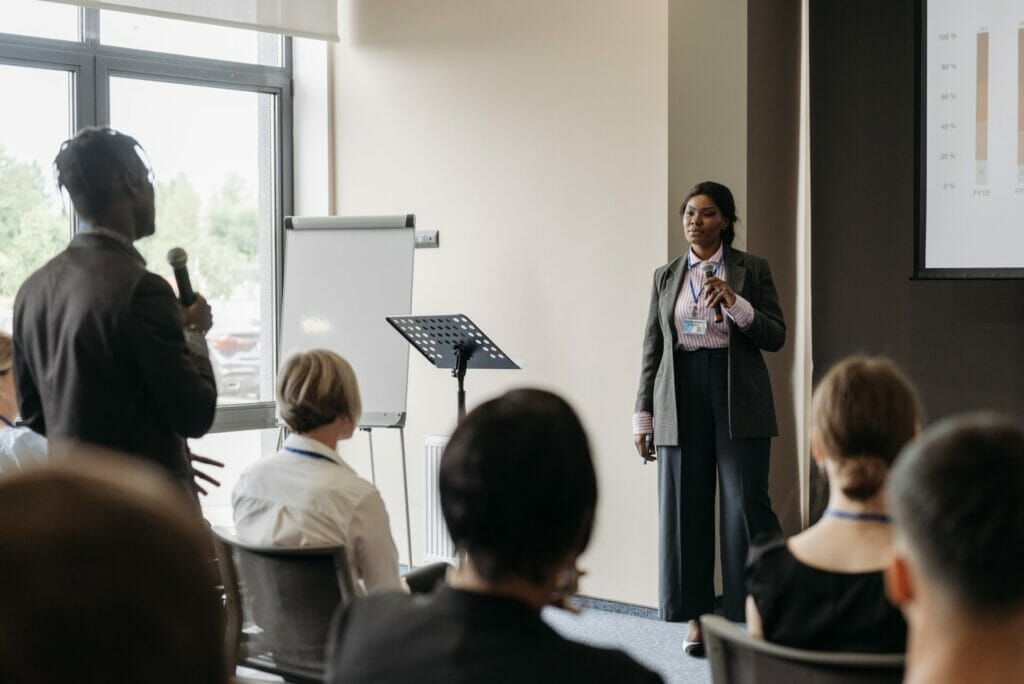Introduction
In a world where everyone seems to be talking but few are truly listening, there is a unique art—active listening. Why is Active Listening so Important? This skill, often underrated, holds the power to enhance connections, relationships, and our understanding of one another in our nerve-racking daily lives. It’s not just a talent; it’s a transformative tool. Dive into the profound impact of active listening and discover its significance in fostering meaningful connections. Elevate your relationships through the art of truly hearing others.
Imagine yourself in a particular situation. You and another person are having a meaningful conversation. Your whole cognitive concentration is intertwined with the fabric of your speech. It’s not about arranging your next verbal response. Your eyes lock with theirs as a quiet sign of agreement, and you respond with the utmost care. You are absorbing their ideas and feelings, as well as their words. This is the essence of active listening, my buddy.
We’ll set out on a trip to investigate the deep significance of attentive listening in this essay. We’ll dissect its core components. We’ll discover the profound benefits it offers in our personal and professional lives. We’ll delve into the techniques that can help us master this art. Moreover, we’ll confront the demanding situations and barriers that stand in the way of turning into powerful listeners. We’ll offer sensible answers to triumph over them.
Join us as we discover the ever-evolving internationality of the virtual generation. We’ll discover why, despite being surrounded by screens and smartphones, listening well is still cool. If you want to succeed in your relationships, at business, or feel more connected to the world, then listening well is crucial.
So let’s begin this path of comprehension, development, and connections. We’ll discover why listening well is even more great than you might have thought.
Key Takeaways:
- You will learn a great deal about the craft of active listening from this post. You will understand the power of listening. You’ll discover how it goes beyond hearing. It can impact your personal and professional lives.
- Dive deep into the basics of active listening. Learn the building blocks of active listening. Learn about its core elements and defining characteristics. We’ll explore the crucial components that make this skill so impactful.
- Learn how active listening can enhance your communication skills. It can also strengthen your relationships and promote personal development. Discover the direct hyperlink between active listening and achievement in your expert lifestyle.
- We’ll unveil the secrets of active listening strategies. These techniques include reflective listening, asking open-ended questions, non-verbal conversation, and disposing of distractions. These abilities will permit you to become a targeted and sympathetic listener.
- Overcoming Challenges: Face obstacles to active listening, such as bias and outside distractions. Arm yourself with workable solutions. We’ll explore how mindfulness and self-awareness play crucial roles.
- Explore the effect of technology on active listening. Discover techniques to hold on to this vital talent. Do so even in a world dominated by monitors and devices.
- Are you an educator or a leader? You’ll find insights into coaching and listening to others. This applies whether you are in a classroom or workplace.
- This discussion will provide you with the necessary tools. You will use them to establish more meaningful and lasting connections with people. You can leave a lasting impression on your personal life, professional activities, or any social contact. Master the skill of attentive listening.

What is active listening?
A. Definition and Explanation
Active listening is a communication technique. It involves not only hearing the spoken words but also understanding and engaging the speaker. It’s about being gifted, focused, and attentive through communication. In essence, energetic listening goes beyond hearing. It entails processing, expertise, and responding to the statistics shared.
B. Contrasting Passive Listening with Active Listening
Passive listening involves only hearing phrases without engaging with the speaker. In passive listening, the primary focus is on the speaker’s words. People make little to no effort to understand the underlying message. They also don’t try to understand feelings or intentions.
Active listening stands in stark contrast. It includes a deeper degree of interaction and engagement. It goes beyond surface-level words. It grasps the speaker’s perspective, feelings, and needs.
C. The Core Elements of Active Listening
Active listening comprises several key elements, each contributing to its effectiveness.
1. Reflective Listening
Reflective listening includes mirroring the speaker’s terms, feelings, and intentions. It allows the speaker to feel heard and demonstrated. This fosters a deeper connection and expertise.
2. Clarifying and Paraphrasing
To make sure you’ve understood the speaker, lively listening encourages you to make clear what you’ve heard. Paraphrase what you’ve heard. This minimizes misunderstandings and promotes effective communication.
3. Nonverbal signals
Active listening requires nonverbal signs and symptoms. These include keeping eye contact, nodding, and using open body language. They signify your attentiveness and hobby, making the speaker feel valued.
Benefits of Active Listening
A. Improved Communication
Active listening is the cornerstone of effective verbal exchange. By educating others, you could enhance your ability to express your thoughts. This improved communication leads to the following benefits:
1. Enhanced Understanding of Others
Understanding others’ views and feelings lets you tailor your communication to their desires. This fosters stronger relationships.
2. Strengthening of Relationships
Active listening nurtures trust and respect in personal and professional relationships. It makes others feel valued and appreciated.
B. Personal Development
The benefits of active listening extend to personal growth and development. Here’s how:
1. Increased Empathy and Emotional Intelligence
You can also boost your emotional intelligence and empathy with the aid of listening. This enables you to relate to others more and meet their needs.
2. Better Problem-Solving Skills
Active listening improves your ability to solve problems by ensuring you comprehend them. This results in better solutions.
C. Professional Success
In an expert context, active listening can be a game-changer.
1. Effective Leadership and Teamwork
Leaders who show interest are much more likely to encourage recognition and collaboration in their corporations. Effective teamwork becomes feasible when everybody feels heard and valued.
2. Career Growth and Customer Satisfaction
For individuals, active listening can lead to career growth. Employers value personnel who can speak and understand consumer or client wishes. This, in turn, enhances patron delight and loyalty.
D. Conflict Resolution
Active listening is a potent tool for resolving conflicts.
1. Reducing Misunderstandings
By actively listening, you can identify and deal with capability misunderstandings before they escalate into conflicts.
2. Building Trust
In conflict situations, active listening builds trust between parties. It demonstrates a commitment to finding unusual floors and mutually useful solutions.
Active Listening Techniques: Mastering the Art for Success
A. Reflective Listening
1. Repeating and Confirming
Repeating and confirming is a fundamental aspect of reflective listening. It entails reiterating what the speaker has said. Make sure that you’ve understood their message efficiently. This approach no longer simply indicates that you’re engaged in the communication. It also provides the speaker with a warranty that their mind and emotions are being mentioned.
Reflective listening is a first-rate technique. It’s useful for non-public communication and business conventions. It promotes openness and trust, which makes it simpler to establish connections with people.
2. Paraphrasing
Paraphrasing is another essential component of reflective listening. It entails rephrasing the speaker’s phrases on your own. It means keeping the middle. This method lets you illustrate your information and empathy. It can be exceptionally effective in diffusing conflicts and resolving misunderstandings.
B. Asking Open-Ended Questions
1. Encouraging Deeper Conversation
Your ability to ask broad questions may be really helpful when you go further into a subject. Such questions can’t be answered with simple “yes” or “no” responses. They invite the conversation starter to expand on their thoughts and feelings. Use open-ended questions. You may discover complex topics and better understand the alternative character’s attitude.
2. Promoting Exploration of Ideas
Open-ended inquiries inspire the investigation of ideas in addition to supporting deeper conversations. You may also foster a culture of creativity and problem-solving. Ask questions that invite people to share their thoughts and views.
C. Non-Verbal Communication
1. Eye Contact and Body Language
The use of nonverbal clues is crucial in active listening. You can show the other person that you’re interested in keeping eye contact. You can also nod and smile. It conveys appreciation and attentiveness, fostering advantageous surroundings for communication.
2. Nodding and Mirroring
Nodding and mirroring are non-verbal cues that signal your settlement and knowledge. These subtle movements reassure the speaker that you are on the same web page. This makes them feel heard and valued.
D. Eliminating Distractions
1. The Role of Focus and Concentration
To be an effective, lively listener, it’s essential to dispose of distractions. It’s also important to preserve awareness. Find a quiet place for conversations. Give the speaker your full attention. This indicates appreciation. It also lets you soak up data and respond thoughtfully.
2. Putting Away Electronic Devices
In today’s virtual age, digital gadgets may be a sizable barrier to active listening. To excel in this skill, it’s vital to put away your smartphone and other devices during conversations. By doing so, you signify your commitment to the dialogue and prevent distractions.

Active Listening in Different Contexts
A. At Home
Active listening can transform your relationships with your family members. You can better understand their needs and issues. Use strategies like reflective listening. You can also use open-ended questions. This ultimately enhances your interactions.
2. Resolving Conflicts with Loved Ones
Conflict is natural in any family. Active listening can be an effective tool for resolution. When family members feel heard and understood, it’s easier to find unique solutions and reach compromises.
B. At Work
1. Enhancing Productivity and Teamwork
In a professional setting, active listening is critical. By using those strategies, you can enhance productivity and teamwork. When individuals feel heard and valued, they’re more encouraged to collaborate correctly in a group.
2. Resolving Workplace Disputes
Workplace disputes can harm productivity and morale. Active listening may be a key strategy for resolving conflicts. It encourages personnel to express their worries and ideas. This guides them toward useful solutions.
C. In Healthcare
1. Enhancing Patient Care and Satisfaction
In healthcare, active listening is crucial for providing extremely good care to the affected person. Doctors who actively pay attention to their patients accept this as true. They may make more accurate diagnoses and treatment plans.
2. Building a stronger doctor-patient relationship
The basis of medical doctor-patient dating is communication and agreement. Patients who are actively listened to report feeling heard and understood. This is vital for their well-being.
Mastering energetic listening techniques can profoundly affect your private and professional lives. You can use those skills in different situations. This can improve relationships, solve conflicts, and boost productivity. Active listening isn’t just a communication tool; it’s a pathway to success in all aspects of life.
Unraveling the Art of Active Listening in a Distracted World
Common Obstacles to Active Listening
Active listening encounters numerous roadblocks that can avert its effectiveness. Let’s dissect those boundaries and understand how they affect our potential to connect.
1. Improving Family Relationships
- Prejudice and Bias: Prejudice and bias are important impediments to energetic listening. Our preconceived notions can prevent it. Our biases can color the way we recognize data. This makes it hard to genuinely pay attention to someone else’s angle.
- Distractions: The virtual age is full of distractions. The normal pings of social media notifications and the trap of multitasking are some of them. These distractions regularly fragment our attention. They also hinder our ability to engage fully
- Lack of Time: In a world that values pace and efficiency, we often locate ourselves briefly on time. We might rush through conversations because we don’t have enough time. This might make us neglect the depth of lively listening. Strategies to Overcome These Barriers.
Strategies to Overcome These Barriers
In conquering those hurdles, it’s important to use strategies. We need to improve our listening and communication skills.
Mindfulness and Self-awareness
To fight prejudices and biases, we ought to practice mindfulness and self-recognition. When we’re mindful of our personal biases and feelings, we will better manage their impact on our interactions. This awareness empowers us to actively pay attention without judgment.
Time Management and Prioritization
The shortage of time is a present-day woe; however, powerful time control can paint wonders. Prioritize conversations. Set aside committed listening time. Fend off the urge to hurry through discussions. This can raise your energetic listening game.
Why Active Listening Matters
Active listening is not simply listening to phrases but comprehending and processing them. It’s crucial to make an honest effort to realize the opposite character’s phrases, emotions, and dreams. It extends beyond the apparent. It may improve your relationships, communication skills, and ability to solve difficulties.
- The Impact on Professional Life: Active listening is a game-changer in the workplace. Employees who actively pay attention are more productive, as they can grasp commands and comments with precision. This ability fosters higher collaboration, increases innovation, and fosters advantageous painting surroundings.
- Enhanced Personal Relationships: Active listening is equally important in our personal lives. It promotes trust, minimizes misconceptions, and leads to deeper interactions. Actively listening to couples, friends, and family members creates stronger, happier relationships.
- Social Interactions: Active listening distinguishes people in a culture where there is constant noise and distraction. It enables both making new connections and fostering old ones. You display respect, empathy, and a sincere interest in different people. You actively concentrate on them.
B. Techniques for Teaching Active Listening
Now that we’ve mounted the significance of active listening, let’s find out a few powerful techniques. We will use these strategies to educate and nurture this ability in people.
1. Role-Play and Simulations
Role-playing and simulations are powerful tools for teaching lively listening. Set people in situations where they need to concentrate actively. This can help them understand the cost of this skill. Here’s how it works:
- Set up scenarios: Create situations that mimic real-life conditions. For instance, a commercial enterprise meeting, a therapy consultation, or an informal communique amongst friends.
- Assign Roles: Ask individuals to take on specific roles, such as the speaker and the listener.
- Debrief and Reflect: After the role-play, have interaction in discussions about what labored and what didn’t. Encourage contributors to reflect on their listening competencies.
2. Workshops and Training Programs
Workshops and schooling applications are a more dependent method for coaching lively listening. They provide participants with guidance, practice, and valuable insights. Here’s how to structure these programs effectively:
- Identify Goals: Determine what specific active listening skills you want to impart to participants. This could range from empathetic listening to paraphrasing.
- Practice Sessions: Incorporate activities that require participants to actively concentrate and reply accordingly.
- Feedback and Improvement: Provide optimistic comments and possibilities for improvement. Encourage self-assessment and a mirrored image.

Frequently Asked Questions. Why is Active Listening so Important?
Why is it vital to develop desirable listening abilities in private and expert relationships?
Active listening is vital for both personal and expert relationships. It demonstrates that you’re listening with complete attention, looking to recognize what is being stated. It fosters a lifestyle of respect and reduces conflicts. It also enables the building of more potent connections. This is achieved by showing that you’ve heard and valued the speaker’s input.
How can one transform into an active listener? Why is this variation vital for interpersonal verbal exchange?
Becoming a better listener means being engaged in communication, both verbally and non-verbally. Using an energetic listening approach is part of this. This transformation is essential. It allows you to recognize others and replicate their views. It also helps you resolve conflicts through improved work-related communication.
What strategies can be employed to grow to be a higher listener, in the place of job surroundings?
You can improve your active listening skills at work by nodding to show you’ve heard everything. Also, avoid interrupting and put your phone away to focus on the speaker. These techniques help you keep records and share valuable talents within the organization.
Why is the function of a lively listener considered so vital inside the administrative center? How does it beautify expert achievement?
In enterprise, energetic listening is an important skill. It ensures you’re not just announcing the proper phrases but also knowing what’s being said. It results in an appropriate reaction. This helps you develop stronger connections. It helps you make smart judgments. Ultimately, it enhances your overall workplace performance.
How can active listening in the administrative center contribute to a more harmonious and effective team dynamic?
Active listening increases your recognition of the world around you. This fosters deferential surroundings and lessens crew member disagreement. Listening to the whole message and considering different viewpoints fosters a harmonious and productive team dynamic.
What methods can you use to listen carefully during important business meetings and conversations?
Good active listeners naturally nod their heads and provide affirmation. They do this while listening to speakers during business meetings and conversations. These techniques help you remember information and maintain focus during work-related discussions. They also help you keep the relevant details in mind.
How does getting to know lively listening help you become a more powerful leader and communicator?
You may give the speaker your entire attention. Remember knowledge. And efficiently solve problems by being an active listener. Ensuring that people around you feel respected and heard enhances your ability to lead and communicate.
What are a few excellent ways to encourage active listening in your business? Why is it beneficial?
There are several great ways to promote lively listening in your organization. These consist of working towards listening to a person without interruption. They also involve reflecting on their viewpoints. Certainly, they look to understand different views. This tradition is beneficial because it encourages open communication. It also builds a sense of recognition among crew members.
Why is active listening now not just an ability but also a trait that sets you apart in both your personal and professional lives?
Being a powerful, lively listener isn’t just a skill. It’s also a quality that sets you apart. It shows that you truly understand them. It’s a technique to demonstrate that you are interested in other human beings’s critiques and to bolster ties, both personally and professionally.
How are you able to use active attention to build stronger connections with your colleagues, customers, and superiors?
By practicing active listening, you may cross deeper into conversations, reflect on what others are pronouncing, and keep in mind special viewpoints. This enables you to absolutely apprehend their views and share statistics efficiently, accordingly building stronger connections with colleagues, customers, and superiors.
Conclusion
In conclusion, the importance of lively listening cannot be overstated. This talent has a profound impact on both the expert and private elements of lifestyles. It enhances conversation, fosters empathy, and ends in stronger connections. As a crucial talent, active listening ought to be nurtured and made knowledgeable.
We urge our readers to engage in conversations. Practice empathy and try to be better listeners. If you try to improve this ability, you’ll see a nice transformation in your interactions and relationships.
In a noisy international world, active listening is a beacon of connection. It’s full of ever-increasing virtual communiques. Embracing this talent can open doors to higher expertise. It can also lead to richer relationships and a more harmonious world.

Sarah Andrews’ work on relationships is informed by a breadth of experience and a strong interest in human nature. Sarah, who holds a Psychology degree and has a good eye for nuances, delves into the complexity of communication and emotion, delivering insightful insights for readers seeking personal growth and emotional pleasure. Sarah hopes that her empathic approach and insightful suggestions will motivate readers to understand themselves and their relationships better.
